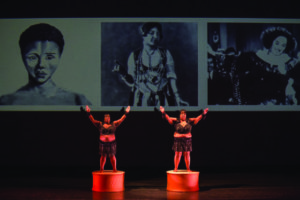
Overwhelmed and teary-eyed, we sat holding each other in silence as we witnessed a full-circle moment. More than a decade of dance that began with timid steps in a basement studio led us to the home of bellydance: Cairo, Egypt. At the Egyptian Center for Culture and Art, the Mazaher ensemble performed the music and songs of the Zar, a ritual used by North African women to gain relief from spirits through rhythmic movement. That night, we believe that Raks Africa released our jinn or as our southern-gospel sisters would say, we gave up the ghost. It has been a long road to that release.
When we started as the bellydance duet, Raks Africa in 2006, we knew that we would be battling a multitude of society’s demons. The stereotypical view of a bellydancer is one of a young, slight, fair temptress, dancing for the pleasure of a man. We are full-figured, African-American grown women who dance for the sheer joy of being in tune with our bodies. And historically as well as today, one can find Egyptian men, women and children shimmying with great delight at a wedding or on a Nile cruise. Yes, there are social norms that affect the image of the dance here in the US, as well as in Egypt. But at its core, what we know as bellydance continues to be a source of community joy and healing. So we named ourselves Raks Africa, Arabic for the Dance of Africa, thus rooting the dance in its home and staking our claim as, “Big bellied girls doing big things.”
So we danced. And the more we danced the more it became clear to us that we could do more to fight the demons that plague our community. So we started the Girls Raks Bellydance and Body Image Program in a home in North Oakland in 2010. Our intentions were to make it clear to young women that they were not alone. Not only did they have allies in us, and many women around them, but also they had the means within themselves to thrive. They could resist the pressure to not be themselves, to mold themselves into someone else’s image of womanhood and that they could recover from the loss of loved ones, the loss of self-definition, and live a vibrant life of their own choosing.
So we taught them how to bellydance, and listened to their stories about how they and other people view their bodies. They learned new tools that they used to stay strong and love themselves fiercely. Girls Raks would expand to include their participation in a production with professional bellydancers from around the Bay Area, and has since expanded to provide special workshops for community groups that work with young women.
Then we decided to tackle even bigger demons. We could not ignore the socio-political upheaval that the 2011 Egyptian revolution brought to the world stage. And yet it was the voices of Egyptian women that captured our attention. So we researched, asked questions, listened, made connections and discovered a women’s movement that the US media muffled.
From there we began to connect the dots. Bellydance is the perfect vehicle for making a global connection around the struggles of women and girls who are challenging their society’s norms about womanhood, and establishing themselves as leaders in social movements. Both the dance and women have had to fight to exist and flourish on one’s own terms. So we shifted our focus to building solidarity between women and girls in the US and Egypt.
In December of 2014, we travelled to Cairo, Egypt. In those seventeen days, we immersed ourselves in modern day, post-revolution Cairo. We spoke with feminist leaders from groups like HarrassMap, who train women and men to intercede when they see harassment on city streets. We witnessed street art that told stories of resistance and provided a radical new vision of Egyptian life. We broke bread and conversed with writers, photographers, waiters, maids, and dreamers, and listened to their hopes and fears about the Egypt of tomorrow. And yes, we danced. Bellydance masters Raqia Hassan and Hoda Ibrahim schooled us on sharqi, shaabi, the history of the dance and women’s role in it.
All of this comes into play as we confront old demons with a new direction in 2015. This involves a further evolution of Girls Raks and our own contribution to the fight against violence against women. For us that means challenging the false perceptions about the agency of women in predominately Islamic countries and exploring how systemic oppression knows no geographic or ethnic boundaries.
Dancing with demons has become a part of the process of self-possession for Raks Africa. It is our hope that it is one that will contribute to the liberation of others as well.
This article appeared in the April 2015 issue of In Dance.

